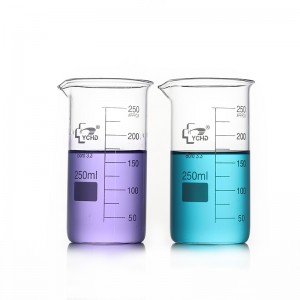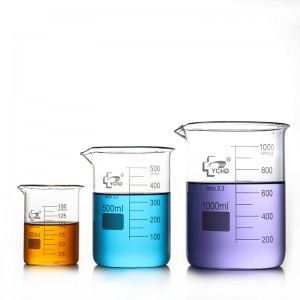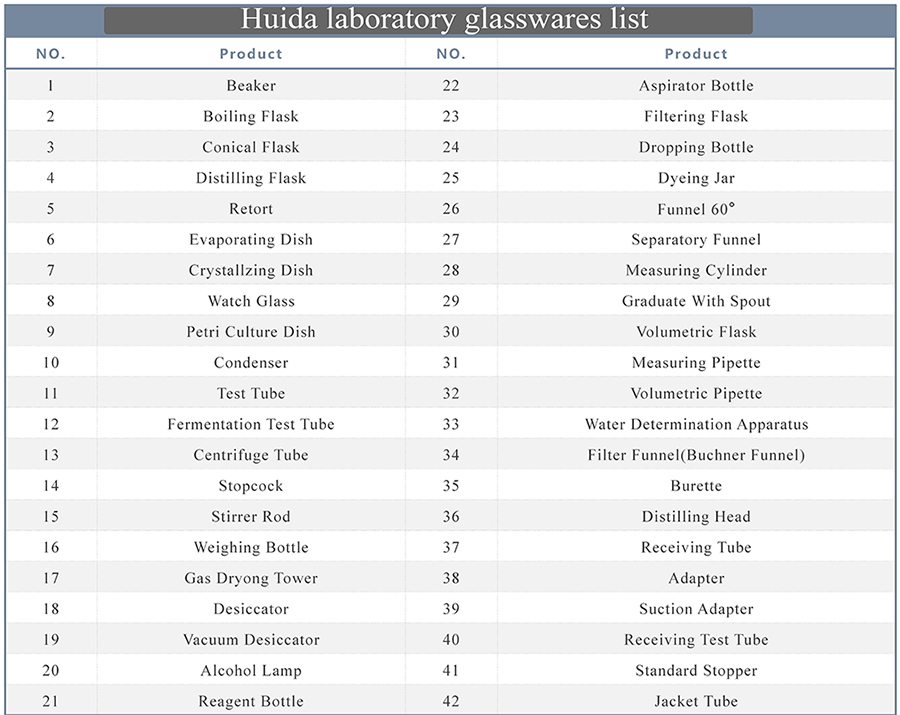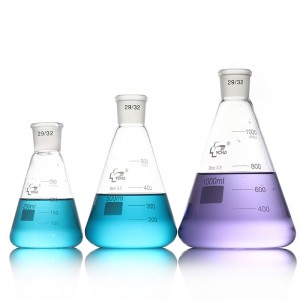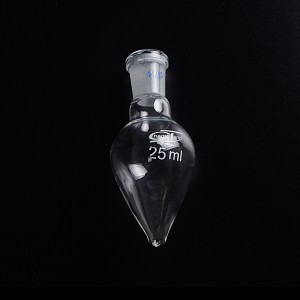Welcome To Huida
High Temperature Resistance Boro 3.3 Glass Beaker with Graduation and Spout
Beaker Introduction
Beakers are often graduated, that is, marked on the side with lines indicating the volume contained.
For instance, a 250 ml beaker might be marked with lines to indicate 50, 100, 150, 200, and 250 ml of volume. These marks are not intended for obtaining a precise measurement of volume (a graduated cylinder or a volumetric flask would be a more appropriate instrument for such a task), but rather an estimation. Most beakers are accurate to within ~10%.
Product Specification
The dimensions are all measured by hand, so there may be some errors. Please contact us for the specific freight.
|
1101 |
Beaker low form With spout and printed graduations | |
|
Capacity(ml) |
O.D.(mm) |
Height(mm) |
|
5 |
22 |
30 |
|
10 |
26 |
35 |
|
25 |
34 |
50 |
|
50 |
42 |
60 |
|
100 |
51 |
70 |
|
150 |
60 |
80 |
|
200 |
65 |
88 |
|
250 |
70 |
95 |
|
300 |
80 |
110 |
|
400 |
80 |
110 |
|
500 |
87 |
118 |
|
600 |
90 |
125 |
|
800 |
100 |
135 |
|
1000 |
106 |
145 |
|
2000 |
130 |
185 |
|
3000 |
150 |
210 |
|
5000 |
170 |
270 |
|
10000 |
217 |
350 |
|
1102 |
Beaker tall form With spout and printed graduations | |
|
Capacity(ml) |
O.D.(mm) |
Height(mm) |
|
25 |
30 |
55 |
|
50 |
38 |
70 |
|
100 |
48 |
80 |
|
150 |
54 |
95 |
|
250 |
60 |
120 |
|
400 |
70 |
130 |
|
500 |
75 |
140 |
|
600 |
80 |
150 |
|
800 |
90 |
175 |
|
1000 |
95 |
185 |
|
2000 |
120 |
240 |
|
3000 |
135 |
280 |
Uses and methods of tall form beaker and low form beaker
[Application]
The beaker is the most commonly used glassware in laboratories. It is widely used for heating, dissolving, mixing, boiling, melting, evaporating and concentrating, diluting, and clarifying precipitation of chemical reagents. Different specifications and sizes have different uses. A beaker with a volume of 1~25mL is mainly used for microanalysis, 50~2000mL is mainly used for constant analysis, and 3000~5000mL is mostly used for industrial production units as small batch production tools or as containers in laboratories. Sometimes it is used instead of water tank, electrolytic tank, etc. The tall form beaker is suitable for the heating reaction of milky substances or light oils and liquids that are prone to foaming and spilling. Because its height is higher than the low form beaker of the same specification, the liquid level observed during operation is larger and it is easy to see clearly. The volume of 600 ~ 1000mL can be used instead of electrolytic cell, cooling tank or freezing point tank. In operation, it has a smaller volume than a low-profile beaker of the same height, which can save chemical reagents.
【Instructions】
(1) The beaker must be cleaned before use. For a new beaker that has not been used, it can be cleaned with tap water and then rinsed with distilled water. As for the used beaker, because of the various chemical stains on the wall, it will directly affect the test results, so it is often soaked in “lotion”, then the inner and outer walls are wiped vigorously with a brush, and finally rinsed with distilled water. Whether the beaker is cleaned or not, check to see if there are small water droplets on the wall of the cup. The presence of water droplets indicates that there is still a grease film on the wall of the cup. The film is easy to adhere to chemical substances during the experiment and affect the results of the experiment. It must be washed again.
(2) When heating the liquid with a beaker, the volume of the liquid should not exceed 1/3 of the beaker to prevent the liquid from spilling during boiling. After the liquid is poured into the beaker, the outer wall of the beaker must be wiped dry. When moving the beaker by hand, keep your fingers away from the inner wall of the beaker to avoid bringing dirt in. In addition, do not use a beaker to heat and evaporate dangerous chemicals such as concentrated acid (hydrochloric acid, nitric acid, sulfuric acid, etc.), concentrated alkali, mercury, etc., so as to avoid strong corrosive vapor or toxic and harmful gases, polluting the environment or even endangering personal and property safety. When heating the beaker, it should be carried out in an oil bath, a water bath, or a sand bath. Try to avoid direct heating. Because the bottom surface is large and the heating surface is uneven, it is easy to cause bursting. If there is no such equipment, the beaker can be placed on the asbestos net for heating. . After heating, when it is removed from the flame, it cannot be placed in a super-cooled place. Rapid changes in temperature will cause the beaker to burst, causing accidents and losses. Put it on the asbestos board or wooden board.
The following is a list of Huida laboratory glassware, if you are also interested in the following other products, please feel free to contact us, we will reply you as soon as possible.
Send your message to us:
Products categories
Why Choose Us
Yancheng Huida Glass Instrument Co., Ltd. is the experienced manufacturer, mainly produces high quality laboratory glassware and other general labware. The band of “YCHD” boiling glass series and volumetric measuring instruments are well-known all over the world.


